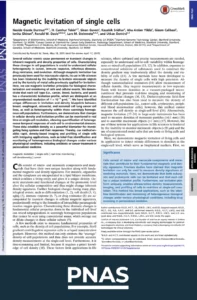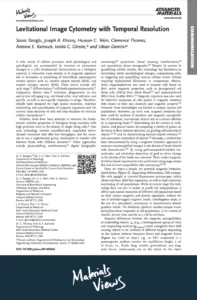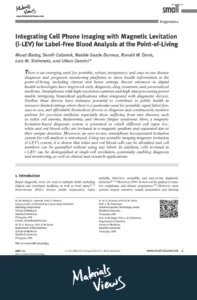Publication summary
Various cellular processes can be monitored through labels, which often require significant processing steps and may inadvertently impact the observed processes. Savas Tasoglu, PhD, and colleagues sought to gain insight into intricate cellular mechanisms using a fundamental property – cells’ volumetric mass density and magnetic signatures. They used magnetic levitation to achieve real-time, high-resolution monitoring of cell populations, leveraging differences in density and magnetic susceptibilities to cause cells to levitate at specific heights. The experimental setup involves a microcapillary tube placed between two neodymium magnets. Within minutes, cells suspended in a gadolinium-based paramagnetic medium form distinct bands in capillary channels that can be monitored through microscopy. The technology was demonstrated to differentiate between red blood cells (RBC), circulating tumor cells, polymorphonuclear leukocytes (PMN), and lymphocytes, as well as between cell states within these subtypes, such as age, health, and activation status. As described by Tasoglu et al., this innovative platform holds promise for cell biology research, and its simplicity and adaptability also make it a potential tool for point-of-care diagnostics in diverse settings, from advanced laboratories to resource-constrained environments.
Levitation Technology uses intrinsic cell properties for gentle viability enrichment
The magnetic levitation approach in this study showcased the potential of using intrinsic cellular characteristics as a distinctive biophysical marker, enabling detailed profiling of different cell types and their variations. This approach has evolved into the core Levitation Technology™ found in the LeviCell® systems, which capitalizes on this principle to enhance sample quality through the separation of viable cells from dead cells and debris without the requirement of cell labeling. The LeviCell platform stands out from traditional viability enrichment methods, offering a more efficient and gentle approach that ensures the maintenance of native cell states for diverse downstream applications, including single-cell multi-omics analyses. Moreover, the LeviCell platform boasts a unique real-time visualization feature, allowing researchers to witness cells in levitation throughout the process. This capability enables sample quality assessment, observation of cell population heterogeneity or behavior, and the extraction of quantifiable metrics.







